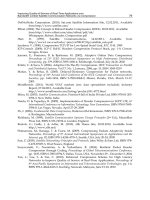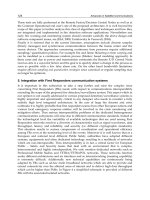Resource Management in Satellite Networks part 10 pdf
Bạn đang xem bản rút gọn của tài liệu. Xem và tải ngay bản đầy đủ của tài liệu tại đây (313.66 KB, 10 trang )
70 Jos´e Ignacio Moreno Novella, Francisco Javier Gonz´alez Casta˜no
The traffic classes established by BSM are based on ITU-T, Tiphon,
3GPP, and UMTS decisions, with adaptation to the satellite environment.
In particular, the BSM standards deal with variable link layer conditions,
high asymmetry and higher delay that are characteristics of satellite networks.
The aim is to enable the satellite network and the Internet Service Provider
(ISP) to ensure acceptable QoS levels and to relate these issues to the BSM
architecture for broadband systems.
In UMTS and, by extension, in satellite networks, four basic service classes
(layer 7) are defined [4]: conversational, streaming, interactive and background.
It is interesting to note that there is no strict one-to-one mapping between
these service classes and the namesake traffic classes (layer 2) [6]: an interactive
application can very well use a bearer of the conversational traffic class, if
the application/service or the user has tight requirements on delay. In the
following sub-Sections the performance requirements for all four service classes
are investigated from the user perspective.
Note that the delay values in the Tables of the following sub-Sections
represent one-way delay (i.e., from originating entity to terminating entity).
3.2.1 Performance requirements for conversational services
The most common service in this category is real-time conversation, such
as telephony speech. Voice over IP (VoIP) and video conferencing also
belong to this category, with increasing relevance as the Internet is rapidly
evolving. This is the only class whose characteristics are strictly determined
by human perception (senses). Thus, this scheme has the most stringent QoS
requirements: the transfer time should be low and, at the same time, the
temporal relation of information entities of the stream should be preserved.
The limit for acceptable transfer delay is very strict (failure to provide low
transfer delays will result in unacceptable lack of quality). However, there
are loose requirements on FER, due to the human perception. For real-time
conversation, the fundamental QoS characteristics are:
• Preserving the temporal relation of information entities in the same
stream;
• Conversational pattern (stringent and low delay).
Some application examples based on conversational services are: con-
versational voice, videophone, interactive games, two-way control telemetry
and Telnet. Table 3.1 summarizes these applications providing the explicit
requirements for each of them [1],[4].
Conversational voice
Audio transfer delay requirements [3] depend on the level of interactivity of
end-users. To preclude difficulties related to the dynamics of voice communi-
cations, ITU-T Recommendation G.114 specifies the following general limits
Chapter 3: QoS REQUIREMENTS FOR MULTIMEDIA SERVICES 71
Medium Application Degree of Data Key performance parameters
symmetry rate and target values
End-to- Delay Information
end variation loss
one-way within a
delay cell
Audio Conversational Two-way 4-25 < 150 ms < 1ms < 3% FER
voice kbit/s preferred
< 400 ms
limit
Video Videophone Two-way 32- < 150 ms < 1% FER
384 preferred
kbit/s < 400
ms limit
Lip-
synch:
< 100 ms
Data Telemetry- Two-way < 28.8 < 250 ms NA Zero
two-way kbit/s
control
Data Interactive Two-way < 250 ms NA Zero
games
Data Telnet Two-way < 250 ms NA Zero
(asymmetric)
Table 3.1: End-user performance expectations - conversational services.
for one-way transmission delay (assuming that echo control has been applied)
[7]:
• 0 to 150 ms: preferred range (below 30 ms the user does not notice any
delay at all, whereas above 100 ms the user does not notice delay if echo
cancellation is provided and there are no distortions in the link)
• 150 to 400 ms: acceptable range (but with increasing degradation)
• Above 400 ms: unacceptable range
We should remember here that there are three types of satellite systems:
LEO, MEO and GEO. Due to their different distance to Earth’s surface, the
propagation delay for the transmitted signal (from Earth to the satellite and
back to Earth) varies from 10 ms to 250 ms (see Section 1.2). This means
that for LEO and MEO satellite systems the preferred range described above
is achievable. However, a GEO system cannot achieve an end-to-end delay
below 250 ms. This means that, according to the satellite system used, the
network designer should be very careful when selecting operational modes.
Other classes have looser requirements and they may be supported by GEO
72 Jos´e Ignacio Moreno Novella, Francisco Javier Gonz´alez Casta˜no
satellites.
The human ear is highly intolerant to short-term delay variation (jitter),
so it should be kept really low. It has been suggested that 1 ms is an adequate
limit. However, the human ear is tolerant to moderate distortion of the speech
signal. An acceptable performance is typically obtained with FER up to 3%.
Finally, a connection for a conversation normally requires the allocation of
symmetrical communication resources.
Videophone
Videophone requires a full-duplex system, carrying both video and audio, and
it is intended for a conversational environment. Therefore, the same delay
requirements of conversational voice will apply, i.e., no echo and minimal
effect on conversational dynamics, with the added requirement that audio
and video must be synchronized within certain limits to provide “lip-synch”
(i.e., synchronization of the speaker’s lips with the words the end-user hears).
In fact, it will be difficult to meet these requirements, due to the long delays
incurred in video codecs. Human eye is tolerant to some information loss,
so that some degree of packet loss is acceptable. It is expected that high
performance video codecs will provide acceptable video quality with FER up
to about 1%. In satellite networks, the same considerations for conversational
voice hold in this case.
Interactive games
Interactive games are games that use the network to interact with other users
or systems. Requirements for interactive games are very dependent on the
specific game considered in terms of bandwidth and delay. Many interactive
games try to exchange high volumes of data, but demand very short delays,
and a delay of 250 ms is reasonable.
Two-way control telemetry
Telemetry is a technology that allows the remote measurement, operation and
reporting of information of interest. Two-way control telemetry is included
here as an example of a data service that does require real-time conversational
performance. Two-way control implies very tight limits on allowable delay and
a value of 250 ms is proposed, but a key difference with voice and video services
is that information loss cannot be tolerated. It is well known that the satellite
channel is error-prone and in order to achieve zero information loss we need
sophisticate error control techniques to ensure it. Delay is a relative issue for
this class of traffic. As far as a satellite network can meet the deadlines that
a particular telemetry service imposes, it can support that service.
Chapter 3: QoS REQUIREMENTS FOR MULTIMEDIA SERVICES 73
Telnet
Telnet (TELetype NETwork) is a network protocol used on the Internet or
local area network connections. In this context, Telnet refers to the program
that provides the client part of the protocol. It allows a remote server access.
Due to the interactivity of the program, Telnet needs a low delay to allow
a user perception of interactivity. This application is included here with a
requirement for a low delay in order to provide back instantaneous character
echoes. By extension we could consider in the same service/application group
any remote access applications like rlogin (remote login)orssh (secure shell).
3.2.2 Performance requirements for interactive services
This second class comprises interactive services (i.e., a human or a machine
request on-line data from a remote server). It is characterized by the request-
response pattern of the end-user. An entity at the destination is usually
expecting a response message within a certain period of time. The Round
Trip propagation Delay (RTD) time is therefore one of the key attributes.
Another characteristic is that the content of the packets must be transparently
transferred (with a low BER). The resulting overall requirement for this
communication scheme is to support interactive non-real-time services with
low RTD.
For interactive traffic, the fundamental QoS characteristics are:
• The request-response pattern;
• Preserving payload content.
Some examples of this service type are: voice messaging and dictation,
data, Web-browsing, high-priority transaction services (e-commerce) and
e-mail (server access). The corresponding requirements are summarized in
Table 3.2 [4].
Voice messaging and dictation
The requirements for information loss are essentially the same as for conver-
sational voice, but, on the contrary, there is more tolerance to delay since
there is no direct conversation involved. Therefore, the main task becomes to
determine the delay that can be tolerated between the user, issuing a command
to replay a voice message, and the actual start of the audio. There is no precise
data on this, but a delay in the order of a few seconds is considered to be
reasonable for this application.
Web-browsing
The main performance factor is the visualization response time, after a Web
page has been requested. A value of 2-4 s per page is proposed. However, a
decrease up to a target of 0.5 s would be desirable.
74 Jos´e Ignacio Moreno Novella, Francisco Javier Gonz´alez Casta˜no
Medium Application Degree of Data Key performance parameters
symmetry rate and target values
One-way Delay Information
delay variation loss
Audio Voice Primarily 4-13 < 1s < 1ms < 3% FER
messaging one-way kbit/s (playback)
< 2s
(record)
Data Web-browsing Primarily < 4 NA Zero
-HTML one-way s/page
Data Transaction Two-way < 4s NA Zero
services - high
priority e.g.,
e-commerce,
ATM
Data E-mail (server Primarily < 4s NA Zero
access) one-way
Table 3.2: End-user performance expectatives - interactive services.
3.2.3 Performance requirements for streaming services
This service class is mainly unidirectional with high continuous utilization
(few idle/silent periods) and low time variation between information entities
within a flow. However, there is no strict limit for delay and delay variation,
since the stream is normally aligned at the destination. Additionally, there is
no strict upper limit for the packet loss rate.
For real-time streams, the fundamental QoS characteristics are:
• Unidirectional continuous stream;
• Preserving time relation (variation) between information entities of the
stream.
The resulting overall requirement for this communication scheme is to
support real-time streaming services with continuous unidirectional data
flows. Table 3.3 details some application examples and the corresponding
limitations [4].
Note that Figure 3.1, Table 3.1, Table 3.2 and Table 3.3 derive from
3GPP TS 22.105 [4]. 3GPP
TM
TSs and TRs are the property of ARIB, ATIS,
ETSI, CCSA, TTA and TTC who jointly own the copyright in them. They
are subject to further modifications and are therefore provided “as is” for
information purposes only. Further use is strictly prohibited.
Chapter 3: QoS REQUIREMENTS FOR MULTIMEDIA SERVICES 75
Medium Application Degree of Data Key performance parameters
symmetry rate and target values
Start-up Transport Packet
delay delay loss at
variation session
layer
Audio Speech, mixed Primarily 5-128 < 10 s < 2s < 1%
speech and one-way kbit/s Packet
music, medium loss ratio
and high
quality music
Video Movie clips, Primarily 20- < 10 s < 2s < 2%
surveillance, one-way 384 Packet
real-time video kbit/s loss ratio
Data Bulk data Primarily < 384 < 10 s NA Zero
transfer/ one-way kbit/s
retrieval,
layout and
synchronization
information
Data Still image Primarily < 10 s NA Zero
one-way
Table 3.3: End-user performance expectations - streaming services.
Audio streaming
Audio streaming is expected to provide better quality than conventional
telephony, thus the packet loss requirements will be correspondingly tighter.
However, there are no conversational elements involved and the delay require-
ments can be relaxed.
One-way video
The main distinguishing feature of one-way video is the absence of conversa-
tional elements. Therefore, the delay requirements will be not so stringent.
Still image
Regarding still images, the human eye is tolerant to information loss. However,
single bit errors can cause large disturbances in still image formats. Therefore,
it is generally expected that there will be zero errors in the transmission of
still images. Delay requirements are low.
76 Jos´e Ignacio Moreno Novella, Francisco Javier Gonz´alez Casta˜no
3.2.4 Performance requirements for background
services-applications
This service class applies when the end-user, typically a computer, sends and
receives data files in background. It is a classical data communication scheme
where the destination is not expecting data within a certain deadline. Hence,
the propagation delay (like that of satellite systems) is not that important
in this case. However, error control is very important, since errors should be
kept to very low levels (in the satellite scenario such feature calls for adequate
coding protection and retransmission schemes).
For background traffic, the fundamental QoS characteristics are:
• The destination is not expecting data before a certain deadline;
• Preserving payload content.
The resulting overall requirement for this communication scheme is to
support non-real time services without any special requirement on delay. A
background application has no delay constraint. In principle, an essentially
error-free delivered information is the only requirement for applications in
this category. However, there is still a delay constraint, since data is effectively
useless if it is received too late. Examples of these applications are: fax, low
priority transaction services, e-mail (server to server), Short Message Service
(SMS), download of databases and measurement records.
Fax
Fax is not normally considered a real-time communication. Nevertheless, there
is an expectation that a fax transmission will take less than 30 s.
Low priority transaction services
An example in this category is SMS. An acceptable delivery delay is 30 s.
Table 3.4 compares the applications on the basis of the service class and the
associated delay requirement [8].
3.3 IP QoS frameworks/models
Many factors influence the user-perceived quality of a telecommunication ser-
vice, from codecs employed to the performance of the network. The constraints
and requirements have been presented in the previous Section 3.2. In this
Chapter we will analyze the mechanisms designed for IP networks to achieve
QoS. This Section addresses the IP layer and as such we keep it very general,
so that the satellite network can be one of the possible scenarios.
It is well known that IP networks were not designed to provide any
Chapter 3: QoS REQUIREMENTS FOR MULTIMEDIA SERVICES 77
Service Conversational Interactive Streaming Background
class (delay 1s) (delay ∼ 1s)(delay < 10 s) (delay > 10 s)
Error Conversational Voice Streaming Fax
tolerant voice and video messaging audio and video
Error Telnet interactive e-commerce FTP, still e-mail arrival
intolerant games Web browsing image, paging notification
Table 3.4: Application examples in terms of QoS.
This table is reproduced from “Radio Resource Management across Multiple Protocol Layers in
Satellite Networks: A Tutorial Overview”, P. Barsocchi, N. Celandroni, F. Davoli, E. Ferro, G.
Giambene, F. Casta˜no, A. Gotta, J. I. Moreno, P. Todorova, International Journal of Satellite
Communications and Networking, Vol. 23, No. 5, pp. 265–305, September/October 2005. ISSN:
15442-0973.
c
2005. Copyright John Wiley & Sons Limited. Reproduced with permission.
QoS guarantees. However, the applications traditionally using IP as a com-
munication technology could perfectly cope with that lack; telephony or
iterative applications over IP (that are nowadays beginning to be used) need
transport networks with very strict QoS support. Such mechanisms vary from
100% guarantee solutions (employing techniques that can be assimilated to
virtual circuit creation/provisioning) to other solutions not providing 100%
guarantees. The over-provisioning approach is also considered but, of course, it
cannot be applied in scarce-bandwidth radio access networks. Besides, offering
different qualities for the data transport service will create new opportunities
for providing several quality levels at different prices. We can conclude that,
in the future, the IP data transport will be QoS-enabled.
The way to provide QoS in IP networks has been discussed for a long
time. The most accepted solutions are IETF’s IntServ [9] and DiffServ
[10]: both IntServ and DiffServ endow the routers with QoS mechanisms,
such as queuing, scheduling and shaping, as illustrated in Figure 3.2. These
mechanisms are implemented in the router interfaces. The main difference
between IntServ and DiffServ lies in the level of detail used by the classifiers
and in the need to keep state information.
The IntServ model provides end-to-end QoS guarantees by reserving
per-flow resources (normally using the RSVP protocol [11]) in all the nodes
along the path. While this architecture provides excellent QoS guarantees,
it has scalability problems in the network core because of per-flow state
maintenance and per-flow operation in routers. It is worth noting that RSVP
is not the only IP reservation protocol, but RSVP is by far the most accepted
one and has become an “integral” part of IntServ networks. There exist even
some commercial RSVP-enabled routers.
RSVP identifies a communication session by the combination of destina-
tion address, transport-layer protocol type, and destination port number. In
IPv6 those two last parameters may be replaced by the flow label. RSVP
is used to reserve resources in the routers along the path between the sender
and the receiver(s). RSVP also allows freeing these resources when they are no
78 Jos´e Ignacio Moreno Novella, Francisco Javier Gonz´alez Casta˜no
Fig. 3.2: QoS mechanisms in a router interface.
longer needed. Normally these reservations are to be policed and it is common
to have an entity termed bandwidth broker (or, also, QoS broker) that takes
the policy decision and communicates it to the routers. This entity will be
studied later in this Section.
The primary messages used by RSVP are the “Path” message, which
originates from the traffic sender, and the “Reservation” message, which
originates from the traffic receiver(s). They are used in the resource reservation
process. RSVP can also explicitly shut down the QoS sessions using RSVP
teardown messages. Teardown messages can be initiated by an application
in an end-system (sender or receiver) or a router as the result of state time-
out. RSVP supports two types of teardown messages: “path-teardown” and
“reservation-request teardown”. Path-teardown messages delete the path state
(deleting the reservation state), travel toward all receivers downstream from
the point of initiation, and are routed like path messages. Reservation-request
teardown messages delete the reservation state, travel towards all matching
senders upstream from the point of teardown initiation, and are routed like
corresponding reservation-request messages.
On the other hand, DiffServ requires no per-flow control in the core
network and, consequently, routers do not maintain any per-flow state and
operation; no reservation protocol exists. As a result, DiffServ is relatively
scalable in the forwarding/data plane, but offers no strict QoS guarantees.
The criterion to classify the packets in core routers relies on the DiffServ Code
Point (DSCP) field in the packet header [12]. DSCP defines three classes of
priority:
Chapter 3: QoS REQUIREMENTS FOR MULTIMEDIA SERVICES 79
• Best Effort (BE): to provide the service in the same way as in the current
Internet, where there are no QoS guarantees, IETF recommends that the
DSCP value should be 000000 (bin).
• Assured Forwarding (AF): The AF group contains four independent classes,
each with three different drop precedence values in the queues. There is no
specified algorithm for each value, but the dropping probabilities must
be increasing and the packets must be marked with AF DSCP value and
must arrive to the destination in the proper order. In case of congestion,
the dropping probability depends on the drop precedence value.
• Expedited Forwarding (EF): EF is designed as the best group. It should
provide very small drop probability, latency and jitter. That is the reason
why this service is sometimes regarded as a Virtual Leased Line (VLL).
This Per-Hop Behavior (PHB) is predestined to handle real-time applica-
tions like video streams. When EF packets enter a DiffServ router, they
should be handled in very short queues and quickly serviced to maintain
lower latency, packet loss, and jitter. Throughput of the EF flow should
be limited to the value that can be handled by each node. It is necessary
to avoid the situation where the queue could overflow and cause flow
degradation. IETF recommends that the EF class should be marked with
the DSCP value 101110 (bin).
Routers should allocate enough resources for the high priority DSCPs,
while the lower ones or the “classical” BE traffic (DSCP 0) may use spare
resources. DiffServ networks require access control in the edge routers, so that
only authorized users can inject packets with high priority DSCPs. Access
control is enforced by the shapers. Depending on the type of edge routers,
this access control can take place in different levels of detail. For instance, in
edge routers connecting the core network to the users (Access Routers,ARs)
this control follows a per-user and per-flow basis, since ARs will handle a
small traffic load. However, for edge routers connecting the core network to
the Internet or other domains, this access control can only proceed at a very
rough level of detail.
Besides the QoS-enabled routers, another entity called QoS broker [13]
is used to control and to manage the network. This entity, for scalability
reasons, can be replicated in the network; moreover, the network can be
hierarchically divided into several areas, as proposed in [14]. In a simplified
way, the QoS broker manages and monitors the network resources in one
particular domain of operation. It also monitors the edges for incoming and
outgoing resource reservations/utilization. The information thereby acquired
is used in conjunction with the policy system information to take admission
control decisions and reconfigurations and to convey them to the routers. A
QoS broker is then an entity that takes Service Admission Control decisions
and performs network device configuration, according to a set of conditions
imposed by the network administration entities (e.g., Authentication, Autho-
rization and Accounting, AAA, System) with the goal of achieving end-to-end









